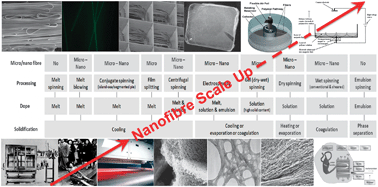Electrospinning versus fibre production methods: from specifics to technological convergence
Abstract
Academic and industrial research on nanofibres is an area of increasing global interest, as seen in the continuously multiplying number of research papers and patents and the broadening range of chemical, medical, electrical and environmental applications. This in turn expands the size of the market opportunity and is reflected in the significant rise of entrepreneurial activities and investments in the field. Electrospinning is probably the most researched top-down method to form nanofibres from a remarkable range of organic and inorganic materials. It is well known and discussed in many comprehensive studies, so why this review? As we read about yet another “novel” method producing multifunctional nanomaterials in grams or milligrams in the laboratory, there is hardly any research addressing how these methods can be safely, consistently and cost-effectively up-scaled. Despite two decades of governmental and private investment, the productivity of nanofibre forming methods is still struggling to meet the increasing demand. This hinders the further integration of nanofibres into practical large-scale applications and limits current uses to niche-markets. Looking into history, this large gap between supply and demand of synthetic fibres was seen and addressed in conventional textile production a century ago. The remarkable achievement was accomplished via extensive collaborative research between academia and industry, applying ingenious solutions and technological convergence from polymer chemistry, physical chemistry, materials science and engineering disciplines. Looking into the present, current advances in electrospinning and nanofibre production are showing similar interdisciplinary technological convergence, and knowledge of industrial textile processing is being combined with new developments in nanofibre forming methods. Moreover, many important parameters in electrospinning and nanofibre spinning methods overlap parameters extensively studied in industrial fibre processing. Thus, this review combines interdisciplinary knowledge from the academia and industry to facilitate technological convergence and offers insight for upscaling electrospinning and nanofibre production. It will examine advances in electrospinning within a framework of large-scale fibre production as well as alternative nanofibre forming methods, providing a comprehensive comparison of conventional and contemporary fibre forming technologies. This study intends to stimulate interest in addressing the issue of scale-up alongside novel developments and applications in nanofibre research.


 Please wait while we load your content...
Please wait while we load your content...